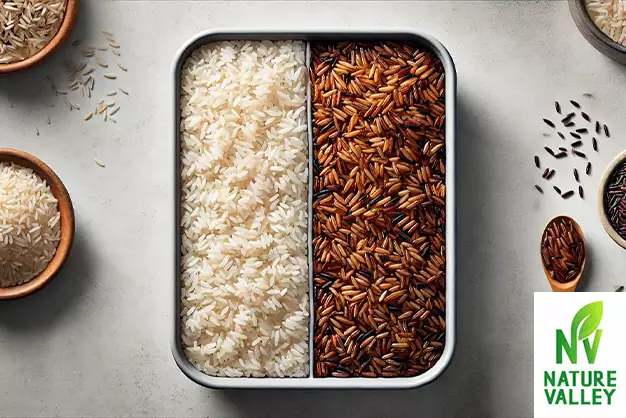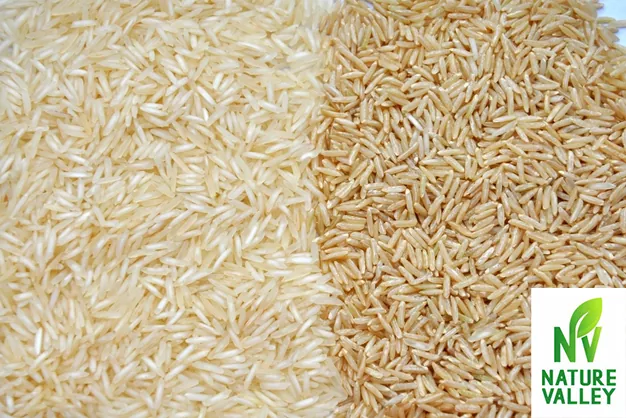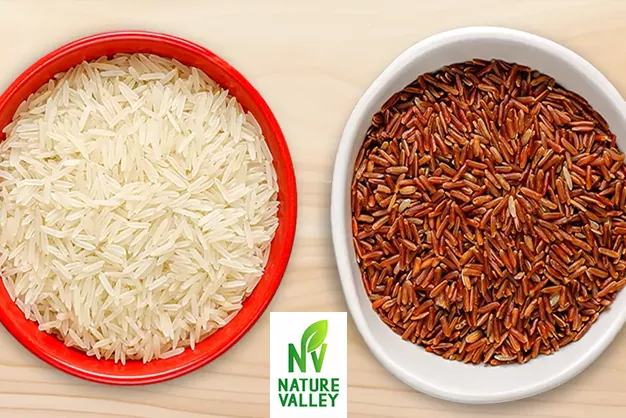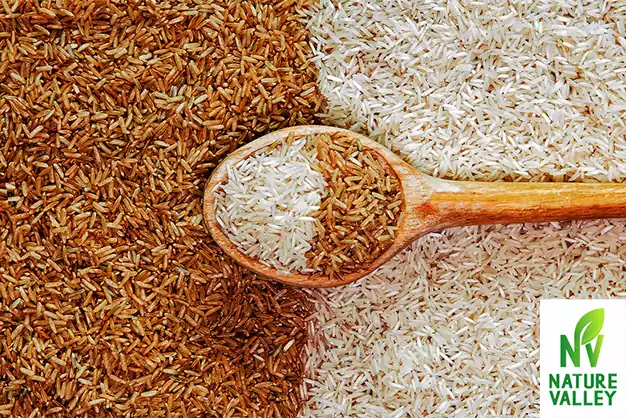What is the Difference Between Basmati Rice and Brown Rice? Rice is one of the most widely consumed staples in the world, providing energy, nutrition, and flavor to millions of people daily. Among the countless rice varieties, basmati rice and brown rice are two of the most popular options. While both have unique qualities and health benefits, they cater to different tastes, dietary preferences, and cooking needs. But how do these two types of rice differ? Which one is healthier? And how can you decide which one is the best fit for your meals? In this blog, we’ll break down the key differences between basmati rice and brown rice, highlighting their nutritional profiles, health benefits, and culinary applications. We’ll also explore how Nature Valley, a trusted name in high-quality rice production, offers premium rice options to meet your needs.

Basmati Rice vs Brown Rice
Basmati rice is a long-grain rice variety that is native to the foothills of the Himalayas in India and Pakistan. Known for its unique aroma, nutty flavor, and fluffy texture, basmati rice is a staple in South Asian and Middle Eastern cuisines. Its name comes from the Sanskrit word basmati, meaning “fragrant,” which perfectly describes its signature quality.
Basmati rice is often used in dishes like biryanis, pilafs, and curries due to its ability to absorb spices and maintain a light, non-sticky texture after cooking.
Brown rice is a whole grain that retains its bran and germ layers, making it more nutritious than its polished counterpart, white rice. Unlike white rice, brown rice undergoes minimal processing, which preserves its natural fiber, vitamins, and minerals. It has a chewy texture, nutty flavor, and is often favored by those seeking a healthier alternative to refined grains.
Brown rice is versatile and can be used in salads, stir-fries, soups, and more, offering a wholesome addition to any meal.
Learn more about our products: tabiat rice
Key Differences Between Basmati Rice and Brown Rice
While both basmati rice and brown rice are nutritious and versatile, they differ in several aspects, including flavor, texture, cooking time, and nutritional content. Here’s a detailed comparison:
- Flavor and Aroma
- Basmati Rice: Known for its delicate floral aroma and nutty flavor, basmati rice has a light and refined taste that pairs well with a variety of spices and herbs.
- Brown Rice: Brown rice has a more robust, earthy flavor due to its bran layer. Its nuttiness is more pronounced, making it ideal for hearty, rustic dishes.
- Texture
- Basmati Rice: The long grains of basmati rice remain fluffy and separate when cooked, giving it a soft yet firm texture.
- Brown Rice: Brown rice has a chewier texture due to its outer bran layer, making it denser and more filling.

- Nutritional Content
Both types of rice offer unique nutritional benefits. Here’s a comparison per 100 grams of cooked rice:
| Nutrient | Basmati Rice | Brown Rice |
| Calories | 121 | 112 |
| Carbohydrates | 25.2 grams | 24 grams |
| Protein | 3.5 grams | 2.6 grams |
| Fiber | 1 gram | 1.8 grams |
| Fat | 0.4 grams | 0.9 grams |
| Magnesium | 14 mg | 43 mg |
Brown rice generally contains more fiber and essential nutrients like magnesium and iron, while basmati rice has a slightly higher carbohydrate and protein content.
- Glycemic Index (GI)
- Basmati Rice: Basmati rice has a lower glycemic index (50–58), meaning it causes a slower rise in blood sugar levels. This makes it a better choice for those managing diabetes or looking to maintain stable energy levels.
- Brown Rice: Brown rice also has a low glycemic index, but its higher fiber content makes it slightly better for blood sugar control compared to white basmati rice.
- Cooking Time
- Basmati Rice: Cooks relatively quickly, typically within 15–20 minutes.
- Brown Rice: Takes longer to cook due to its outer bran layer, requiring about 40–50 minutes unless soaked beforehand.
- Culinary Uses
- Basmati Rice: Ideal for dishes like biryanis, pilafs, and curries where fluffy, aromatic rice is desired.
- Brown Rice: Best suited for salads, stir-fries, and hearty bowls where its chewy texture and nutty flavor can shine.
Difference between basmati rice and brown rice health benefit
Health Benefits of Basmati Rice consists of:
- Supports Digestive Health
Basmati rice contains a small amount of dietary fiber, which aids digestion and promotes gut health.
- Helps Manage Blood Sugar Levels
With its low glycemic index, basmati rice causes a gradual release of energy, making it a smart choice for those managing diabetes or avoiding sugar crashes.
- Provides Sustained Energy
The complex carbohydrates in basmati rice offer a steady energy source, making it ideal for active individuals.
- Naturally Gluten-Free
Like all rice varieties, basmati rice is gluten-free, making it a safe option for those with gluten sensitivities or celiac disease.

Health Benefits of Brown Rice
- High in Fiber
Brown rice contains nearly twice as much fiber as basmati rice, which helps improve digestion, regulate blood sugar levels, and promote satiety.
- Packed with Nutrients
The bran and germ layers in brown rice retain essential vitamins and minerals, such as magnesium, iron, and B vitamins.
- Heart-Healthy
Brown rice’s fiber content and lack of cholesterol contribute to improved heart health by reducing bad cholesterol levels and supporting healthy blood pressure.
- Supports Weight Management
The combination of fiber and protein in brown rice promotes fullness, making it a great option for those looking to manage their weight.
Learn more about our products: tabiat indian rice
Which is better brown rice or basmati rice?
Both basmati rice and brown rice have their strengths, so the choice ultimately depends on your dietary goals and the dish you’re preparing. Here’s a quick guide:
Choose Basmati Rice If:
- You want light, aromatic rice that pairs well with spices.
- You’re making dishes like biryanis, pilafs, or curries.
- You need a quick-cooking rice variety.
Choose Brown Rice If:
- You’re prioritizing fiber and nutrient content.
- You enjoy a chewier texture and nutty flavor.
- You’re preparing hearty, rustic dishes or salads.

Difference between basmati rice and brown rice cooking
Cooking Basmati Rice
- Rinse the rice under cold water to remove excess starch.
- Soak the rice for 20–30 minutes to help elongate the grains.
- Cook 1 cup of basmati rice with 1.5 cups of water for 15–20 minutes. Fluff with a fork before serving.
Cooking Brown Rice
- Rinse the rice to remove any impurities.
- Soak for at least 30 minutes to reduce cooking time.
- Cook 1 cup of brown rice with 2.5 cups of water for 40–50 minutes. Let it rest for 10 minutes before fluffing.
Why Choose Nature Valley’s Rice?
When it comes to high-quality rice, Nature Valley is a name you can trust. Whether you prefer the fragrant aroma of basmati rice or the nutrient-rich qualities of brown rice, Nature Valley offers premium options that meet the highest standards of quality and sustainability.
Benefits of Nature Valley’s Rice
- Exceptional Quality: Every grain of Nature Valley’s rice is carefully selected for superior taste, texture, and nutritional value.
- Sustainability: Nature Valley prioritizes eco-friendly farming practices, ensuring that their rice is good for you and the environment.
- Versatility: From aromatic basmati rice to wholesome brown rice, Nature Valley offers products that cater to a variety of culinary needs.
Conclusion: Which Rice is Right for You?
Both basmati rice and brown rice are excellent choices, offering unique flavors, textures, and health benefits. Basmati rice is perfect for those who love aromatic, fluffy grains that pair beautifully with spices, while brown rice is a nutrient-dense option for individuals prioritizing fiber and whole grains.
By choosing Nature Valley’s premium rice products, you can enjoy the best of both worlds. Whether you’re preparing a traditional biryani with basmati rice or a hearty salad with brown rice, Nature Valley ensures that every meal is as nutritious as it is delicious.
Explore Nature Valley’s rice selection today to discover the perfect grain for your next dish.


